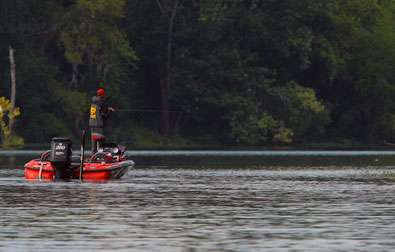
If there are two things that get me revved up, it's when bass have moved onto offshore structure, and I can fish deep running crankbaits.
Just look at my record on Kentucky Lake, where I've won two, had a second and a third in the last four summer events. The crankbait was pivotal in those finishes.
There are many great crankbait anglers on tour, but I think my experience and knowledge of my equipment gives me the edge.
I also have to give credit to my Humminbird Side Imaging Unit for putting me around fish this year that I previously didn't know were there. That's no shameless plug; this new technology is revolutionizing how we find fish, and that's why so many other pros are using it.
I can drive around offshore structure and see how fish are positioned so I can make precise casts and make them bite. Before Side Imaging, I had to spend countless hours casting to fine-tune my pattern and presentation.
On Kentucky Lake, I saw big schools of bait and bass holding off the structure in deeper water, marked them with waypoints, then backed off and made long, meticulous casts into those areas.
The fish were schooled so tightly that I could feel my lure bumping into them and it sometimes came in with fish scales on the hooks. If I didn't feel them, I knew the cast was not in line with where they were.
Of course, I couldn't reach some of these fish had it not been for the Strike King 6XD crankbait that I could get down to 22 feet or more with a long cast. Most deep crankbaits are lucky to hit 17 feet, but the 6XD allowed me to reach fish that other anglers couldn't unless they were throwing jigs or slower presentations.
Because of its design, I can throw the 6XD 70 yards on my 7-11 Quantum KVD Tour Cranking rod. Again, the combination of the rod, line (XPS Fluorocarbon) and lure were integral parts of my presentation. The length of the cast made it possible for me to push the lure beyond its prescribed 20-foot depths, and the sensitive line helped me feel the bait and the fish it was bumping.
However, keep in mind bass don't wake up and say, "Hmmm … I think I'll go eat something that wiggles and looks like a shad."
They will strike these lures out of hunger, but I believe fish on pressured lakes are reacting to the lure because it flashes in their face or does something unusual to set it apart from the rest of the aquatic world around them.
If you're not presenting a crankbait to fish in an erratic fashion, you're going to miss some key bites. Make sure the lure is banging on bottom, changing speeds, or making short, abrupt movements. You can do that by periodically snapping the rod tip with the wrist.
It may take several casts to a group of fish to get one to bite, but when you do, it will activate the entire school.
And when that happens, it's game on!




